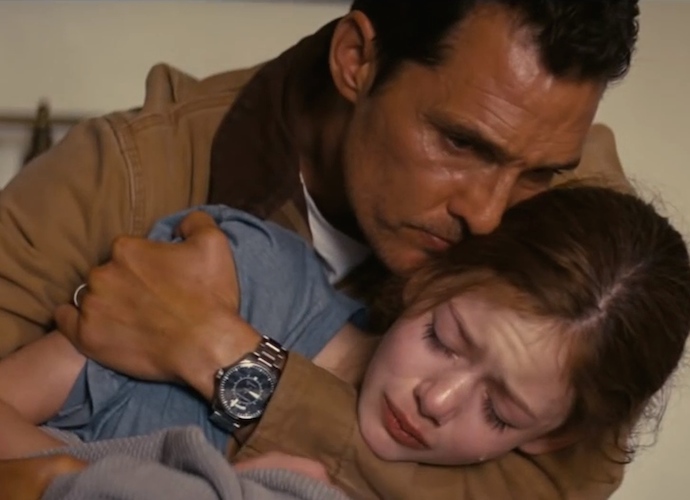‘Interstellar’ Review: 2014 A Space Sickness

2.5/5
Interstellar’s science is top notch, yet its plot and characters are thin, making the experience seem more as a documentary on theoretical science and engineering. If one of Christopher Nolan’s greatest flaws as a storyteller is his esoteric style, then Interstellar is one of his weakest efforts. One of the first and one of the best science fiction films of all time was Fritz Lang’s Metropolis whose central theme was this: The mind cannot function without the heart. This is something Nolan should have kept in mind while crafting Interstellar.
Interstellar is a love letter to Kubrick and Clarke’s 2001: A Space Odyssey to the point where you could easily insert some of the latter’s iconic dialogue into the former’s story and it would fit perfectly because the shots and themes are so similar. This is a hard science fiction film and therefore in need of real, workable science. By employing theoretical physicist Kip Thorne, co-writers and brothers Jonathan Nolan and Christopher Nolan, have managed to create an interesting simulacrum of how certain things could happen. Unfortunately, overlong verbosity and awkward plotting results in much of the fun being lost to detailed explanations that end up creating more questions than answers.
At the center of the story is the story of family and of the power of love but it is rarely given the space it needs for the audience to latch onto it and give it meaning. There is a sense of betrayal felt by daughters toward their fathers — Brand (Michael Caine) lied to essentially save his daughter; Cooper (Matthew McConaughey) left his daughter in the hopes to save her. The losses felt are hardly explored, though McConaughey does work his hardest in giving his scenes with his daughter Murph (played by Mackenzie Foy, Jessica Chastain and Ellen Burstyn progressively) but there isn’t much to glom on to. The twist about the nature of the ghost is diminished because of how obvious the screenplay made it not to mention the overwrought dialogue — TARS: “How will you find her?” Cooper: “Love. It’s the one thing that transcends time and space.”
Well, that and gravity. And tachyons. Plotwise, there are some fairly obvious holes at the center of the story.
Nolan is able to get strong performances out of his actors in any and all of his movies, even when the work doesn’t live up to the actor’s abilities. Interstellar is one of Nolan’s most expositional and least emotionally accessible films. With high concept storylines it’s often best to imbue characters that are well developed so that even if the larger story may not be entirely understandable on the first viewing, you can at least for a bond with the characters and be invested in their survival and conflicts. The struggles surrounding Romilly (David Gyasi) and his obviously fractured sanity after spending almost 23 years in total isolation is given very little screen time. Rather, he’s grown a beard and speaks in fractured couplets. After a lifetime apart, the reunion (as mentioned above) between Cooper and Murph is too brief and lacks any real emotional gravitas. It doesn’t help that McConaughey has very little screen time with any of the Murphs so it becomes difficult for us as an audience to accept and for the actors to develop any real chemistry.
They say that film, despite its element, is only 10% a visual experience. The rest is auditory. Hans Zimmer has worked the soundtrack on nearly all of the Nolan movies, though he seems a bit confused by the film himself. Some of the notes seem to be based on Bear McCreary’s Battlestar Galactica soundtrack, and the rest is a fairly predictable set of sounds that more or less fill the requirements of the script, but don’t add much to the emotional truth that is only vaguely present in the script. Had the feelings resonated better perhaps Zimmer’s score wouldn’t feel as baffled as the rest of us.
By boasting only a small to mid-sized cast in a film with a three hour run time, there should be ample opportunity to develop characters well enough to make them meaningful for the audience. Unfortunately, like all Christopher Nolan films, characters are only archetypes and the plot cannot hold up its internal logic. Given that the screenplay is a merger of two different ones developed by the Nolan brothers, this isn’t exactly that much of a surprise, but one would have assumed they would have at least tried to hammer out another draft or two or sent it through for more coverage before filming. Had the Nolans spent as much time developing the structure as much as they did in applying the sciences then Interstellar might have been a more satisfying experience. It was a clear labor of love, but the audience is left out of those affections.
By seeing it in IMAX, I can say that this is definitely a big screen movie. I’m not sure how well it would translate to other theater screens or eventually onto our TVs, tablets and phones. The investment in Interstellar requires both money and a great deal of time. The spectacle often ends up overtaking the nascent flaws of the plot, but only as you watch it. When it transitions to a smaller format, the spectacle will largely be diluted; the trade off just isn’t worth it. Without its immersive cinematography, Interstellar is a fine documentary on theoretical physics and not much else. It’s a story about humanity without much humanity.
RELATED ARTICLES
Get the most-revealing celebrity conversations with the uInterview podcast!





Leave a comment